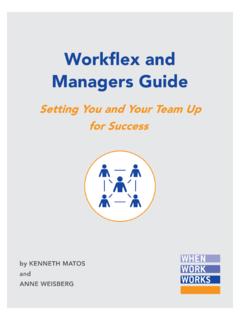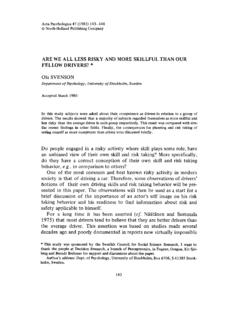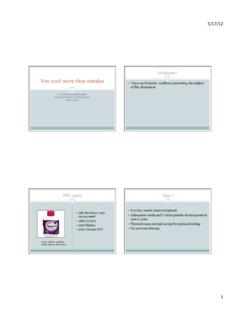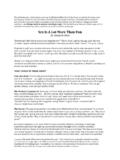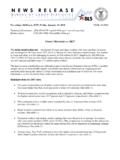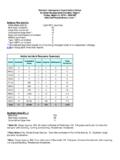Transcription of AcknoWledGeMents - When Work Works
1 Workflex and manufacturing guide iAcknoWledGeMentsWe give special thanks to the Alfred P. Sloan Foundation for supporting research into practical solutions for reinventing work for the mutual advancement of employers and employees, and are grateful to Kathleen Christensen from Sloan for her wise counsel throughout the deepest gratitude goes to Gayle E. Troy, human resources manager, Globe manufacturing Company LLC; Cynthia H. Chandler, human resources manager, Mohawk Industries; Bernadette Scarola, human resources manager, American Sensor Technologies, a TE Connectivity company; Craig W. Porter, president and owner, PlastiCert, Inc. and other manufacturers who provided insight into how to make workflex a reality for production employees in , we would like to thank Kelly Hughes, shareholder, Ogletree Deakins whose astute legal review of the guide helped create innovative and legally compliant suggestions for greater thank Zon-Wei Cheng, When Work Works program manager, FWI and Cassidy Solis, Workplace Flexibility program specialist, SHRM for their ongoing dedication to building When Work Works into a community where best practices are regularly brought to , our thanks to John Boose, creative director, FWI for his design of the report.
2 Workflex and manufacturing guide : more Than a Dream Copyright 2015, Families and Work InstituteUpdated March, 2017 Workflex and manufacturing guide 1As this story shows, workflex is a business strategy for making more effective workplaces for all employees, including production employees. For workflex to be successful, however, human resource and other leaders must follow the example of such companies as Globe to reinvent how they strategize around and im-plement workflex for their specific organizational and employee needs. Workflex and Manufac-turing guide : more Than a Dream is designed to help leaders in manufacturing organizations change the conversation about workflex for produc-tion employees from impossible and easily dismissed ideals to achievable goals for mutual its core, workflex is a process for solving problems and increasing effectiveness and efficiency on and off the 2008, Globe, a manufacturer of protective gear for firefighters with 430 employees, was faced with the challenge of maintaining profitability and retaining skilled workers during a severe economic downturn.
3 To meet this strategic challenge, Globe changed 121 years of tradition and instituted new flexible paid leave and scheduling policies for its production staff. When workweeks were shortened to four days in response to reduced product demand, Globe paid employees who met their weekly goals for half the fifth day and allowed them to use paid leave in half-day increments to make up the difference. In addition, Globe switched from a single mandatory 7 to 3:30 workday for all employees to allowing employees to select any start time between 6 and 8 with a correspondingly later end to their shifts. After a month of planning, coordinating schedules and adjusting child care, commutes and other arrangements, Globe instituted the new flexible hours.
4 The changes have been highly successful, with few complications. Today, Globe reports it is the world s largest competitor in its specific industry. Employees showed their gratitude to the company s owners for implementing a strategy that served the business and its employees by collectively installing a granite bench onsite to com-memorate the mutual success of employer and workflex possible in manufacturing ?For many, the idea of flexible work arrangements for production jobs is little more than a dream. But in reality, it is possible and has been instituted on a number of factory floors across the country. Not only is it possible, it actually helps boost employee satisfaction, and ultimately productivity and the bottom in point: Workflex and manufacturing guide 2 What does workplace flexibility mean in manufacturing environments?
5 Conceptually, workplace flexibility or workflex is the same in any industry: A dynamic partner-ship between employers and employees that defines how, when and where work gets done in ways that work for all (employers, employees, families, clients, & communities). Workflex is not merely a benefit, a form of compensation or punishment, or a collection of specific programs or policies. Unlike these standard organizational carrots and sticks, workflex is not something an organization does for or to employees, but rather is best accomplished with employees. The results of this process can look very different between industries and even among specific organizations in the same industry.
6 For workflex to be maximally effective it must respond to the unique combination of products and services, business strategies, federal and local em-ployment laws, and employees present at a specific organization or worksite. Unfortunately, workflex is seen as impossible by many in manufacturing , with some even fearful to bring up the concept with line managers and employees. manufacturing is often viewed as an inflexible industry where workflex isn t feasible and raising work-life expectations can only lead to disappointment. When workflex is seen as a specific and limited group of policies, like flexible schedules or remote work, this opinion is accurate, but when workflex is seen as a process for reinventing work to achieve maximum success for as many stakeholders as possible, new opportunities emerge.
7 This document includes a variety of suggestions on how to expand workflex options in manu-facturing settings. None of these options are universally applicable but all of them should be considered as inspiration for rethinking what might work in your organization. Each organiza-tion must consider what options make the most sense for them; a policy that Works well in one organization may not be effective or viable in another. Before deciding that an example doesn t make sense for your organization, though, consider two things: 1) Could that option be adjust-ed to fit into your context? And 2) Could you address the relevant employment issues using another, more viable option?
8 What are some unique aspects of the manufacturing industry that influence workflex?In order to understand the workflex opportunities, one must first understand the context in which workflex operates. manufacturing has several characteristics that must be considered when going through a workflex process to improve outcomes for everyone involved. Type of work: Workflex is often discussed in terms of deadline jobs: tasks that can be done anywhere and at any time as long as the finished product can be delivered to the client by a certain deadline. While manufacturers do have some deadline jobs, other employees have coverage jobs: tasks that require employee to monitor or interact with people or objects in a specific place or time.
9 Based solely on the nature of job tasks, deadline jobs tend to have more workflex options available to them than coverage jobs. Workflex and manufacturing guide 3 Maintaining equity: When deadline and coverage employees work in the same space, they may confuse workflex decisions based on job task with other criteria ( , pay, seniority, managerial level, gender, race/ethnicity, etc.) breeding resentment between employees and management. It can be tempting to avoid all workflex options for everyone rather than en-gage in communication efforts around the real reasons for workflex variety. Sequential work and shifts: In some manufacturing processes, individual employees each perform separate (or discrete) functions in a fixed sequence in order to create a product ( , assembly lines).
10 Each employee s work depends on receiving the results of the preced-ing employee in the sequence. Employee schedules and tasks in manufacturing sequences cannot be adjusted individually because changes to one employee s work process necessi-tate changes throughout the rest of the work chain. This can make flexibility complicated, because employees in the same chain may all need to be flexible in the same way. Work-flex options in manufacturing are not just individual interventions but may require work-group-wide changes. Engage equipment designers: Many workflex champions will face the challenge of convinc-ing a reluctant or doubtful leader of the value of workflex.
